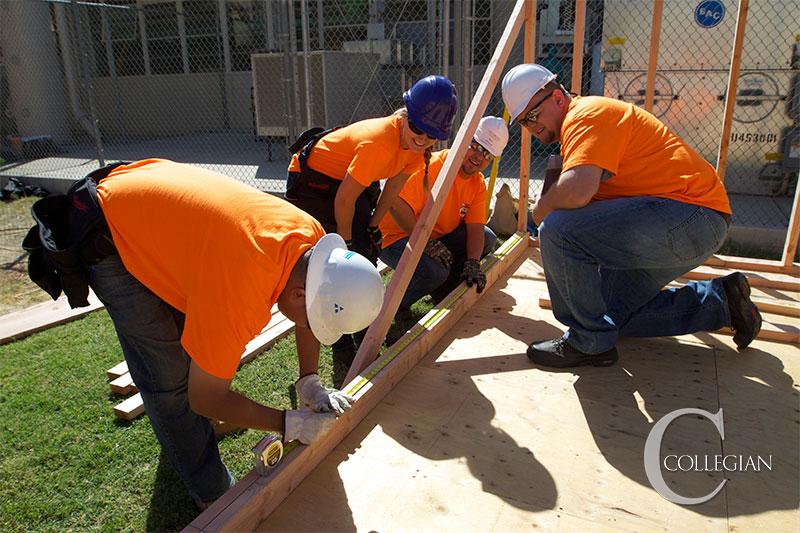
A lab course for construction management students at Fresno State provides an opportunity to put concepts into practice as they build and learn from their projects.
Tucked away into a small fenced-off area near the Grosse Industrial Technology building is a mini-construction zone. Passing students can see four sheds being built by Fresno State students.
Like any other construction site, the students are wearing protective hardhats and bright orange vests.
But the class, construction management assistant professor Brad Hyatt said, is not about building the 12-feet by 12-feet structures.
Instead, the foundation of the class is to give students an opportunity to apply the variety of management skills they have learned in previous classes.
Hyatt said by the time students reach the senior-level class they have only heard in lectures terminology like “project budget,” the “earned value of a project” and a “time-impact analysis” for a schedule.
“The goal of this class is to get them comfortable in the process of managing a real construction process,” Hyatt said. “In previous classes, those terms may have been more conceptual. They are applying those terms here in the lab portion of the class. ‘Oh, I understand. I actually had to write a time-impact analysis because we needed more time on the project.’”
The range of responsibilities includes putting together a budget. Hyatt said the program uses grants to buy the materials the students need, but the students go through the process of budgeting as if they will buy everything.
The dollar signs adding up, Fresno State student Jeff Gonzalez said, has been one of the biggest adjustments of the lab course.
“”I am surprised how much it costs to get five people [the size of each group] to be here on site every day and put together a project like this and actually complete it. Our estimate was about $8,000 for everything, and we’re at $9,000 right now.”
Hyatt said all the groups are behind schedule, but the class and the experience is still very new. He said it is only the second semester the course has existed.
He said the class was born from collaboration with several students. After an initial version of the class was taught last fall, Hyatt and students from the class worked together to determine what it should accomplish.
“It’s going to give them confidence when they go out and work on a real construction project,” Hyatt said. “It’s giving them the confidence of understanding and applying the concepts they’ve learned in the classroom.”
Senior Anthony Davidson said the class reinforces theoretical lessons with hands-on work. The class raises the standard, he said, for teaching and learning construction management.
“Taking the theoretical to the physical””there are some things that aren’t completely linear from the book to the field,” Davidson said. “Things do change. People make mistakes. I think interacting with a group””the groups were randomly selected””teaches you to work with people you don’t know well. I think the human element is the biggest part.”
The teams rotate positions, senior Ryan Johnson said, to give everyone a chance to work as a foreman, superintendent and quality and safety manager.
“You get a good taste of everything, and you can see things from different people’s perspectives,” Johnson said. “It’s a team-building exercise. One of the best things is when you are under stress, a person’s true character comes out.”
He said that, even though the projects are on a smaller scale, the lessons relate to the same issues dealt with on larger projects.
“In this lab, you don’t have trucks moving by or forklifts or other material deliveries,” Johnson said. “It’s kind of simulated. We’re pretty close in proximity, so you have to watch bringing in your materials.”
The sudden interruption of a saw a few feet away makes Johnson pause and smile.
“Then you have the noise,” he said. “It’s a pretty good micro-construction site.”
Hyatt said the projects weren’t meant to be complex, and students initially may have thought they could breeze through the process without any delays.
The reality, he said, hopefully gives the students greater respect for the craftspeople and tradespeople who will be working on projects the students might manage in the future.
“They start to realize it’s not as easy as it looks,” he said. “I tell students all the time, if you get really good at a trade, it’s a skill, and it can be very lucrative.”




